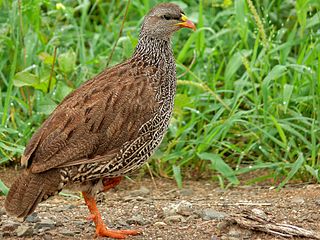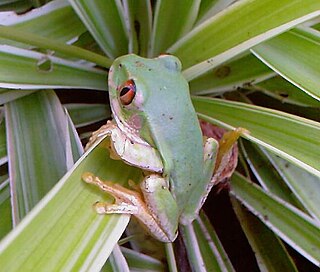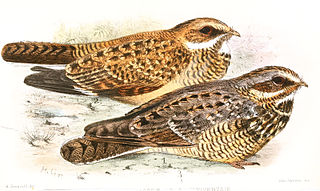
The croaking cisticola is an Old World warbler in the family Cisticolidae.

The red forest duiker, Natal duiker, or Natal red duiker is a small antelope found in central to southern Africa. It is one of 22 extant species form the subfamily Cephalophinae. While the red forest duiker is very similar to the common duiker, it is smaller in size and has a distinguishing reddish coloring. Additionally, the red forest duiker favors a denser bush habitat than the common duiker. The Natal red duiker is more diurnal and less secretive than most forest duikers, so therefore it is easier for them to be observed. In 1999, red forest duikers had an estimated wild population of 42,000 individuals.

The Natal free-tailed bat is a species of bat in the family Molossidae, the free-tailed bats. It is endemic to the island of Mauritius. It is known from fewer than five locations in its range, but it is common at a few sites. It roosts in caves, and it is considered to be an endangered species due to disturbance of its cave habitat.

The Natal long-fingered bat is a species of vesper bat in the family Miniopteridae. It can be found in Angola, Botswana, Democratic Republic of the Congo, possibly Ethiopia, Kenya, Lesotho, Malawi, Mozambique, Namibia, South Africa, South Sudan, Swaziland, Tanzania, Uganda, Zambia, and Zimbabwe. It is found in dry savanna, moist savanna, Mediterranean-type shrubby vegetation, caves, and hot deserts.

The Natal multimammate mouse is a species of rodent in the family Muridae. It is also known as the Natal multimammate rat, the common African rat, or the African soft-furred mouse. The Natal multimammate rat is the natural host of the Lassa fever virus.

The Natal spurfowl or Natal francolin is a species of bird in the family Phasianidae. It is found in Botswana, Eswatini, Mozambique, South Africa, Zambia, and Zimbabwe.

The African yellow warbler, also known as Natal yellow warbler, dark-capped yellow warbler or yellow flycatcher-warbler, is a species of Acrocephalidae warblers; formerly, these were placed in the paraphyletic "Old World warblers".

The Natal forest tree frog is a species of frog in the family Arthroleptidae, subfamily Leptopelinae, and is endemic to the eastern coastal area of South Africa. A typical tree frog, it has large eyes and a broad mouth. Its colouration is highly variable: Some may be bright green, others cream coloured, and some may be cream with olive-green blotches.

The Natal ghost frog is a species of frog in the family Heleophrynidae. It is the only species in the genus Hadromophryne.

The swamp nightjar is a crepuscular and nocturnal bird in the nightjar family found in Africa.

The red-capped robin-chat or Natal robin is a species of bird in the family Muscicapidae.

Vittina natalensis, common name spotted nerite, is a species of small freshwater snail with an operculum, an aquatic gastropod mollusk in the family Neritidae, the nerites.
Paradiaptomus excellens is a species of copepod in the family Diaptomidae. It is endemic to South Africa.
Paradiaptomus simplex is a species of copepod in the family Diaptomidae. It is endemic to South Africa.
Paradiaptomus is a genus of crustacean in the family Diaptomidae. It includes the following species:

The scaly yellowfish, or KwaZulu-Natal yellowfish, is a species of freshwater fish in the family Cyprinidae.

Encephalartos natalensis, the Natal cycad or giant cycad, is a species of cycad that is endemic to the Qumbu and Tabankulu areas of the northern part of the Eastern Cape, and through most of KwaZulu-Natal. The number of mature individuals of this species is declining and the International Union for Conservation of Nature has assessed its conservation status as being "near threatened".














